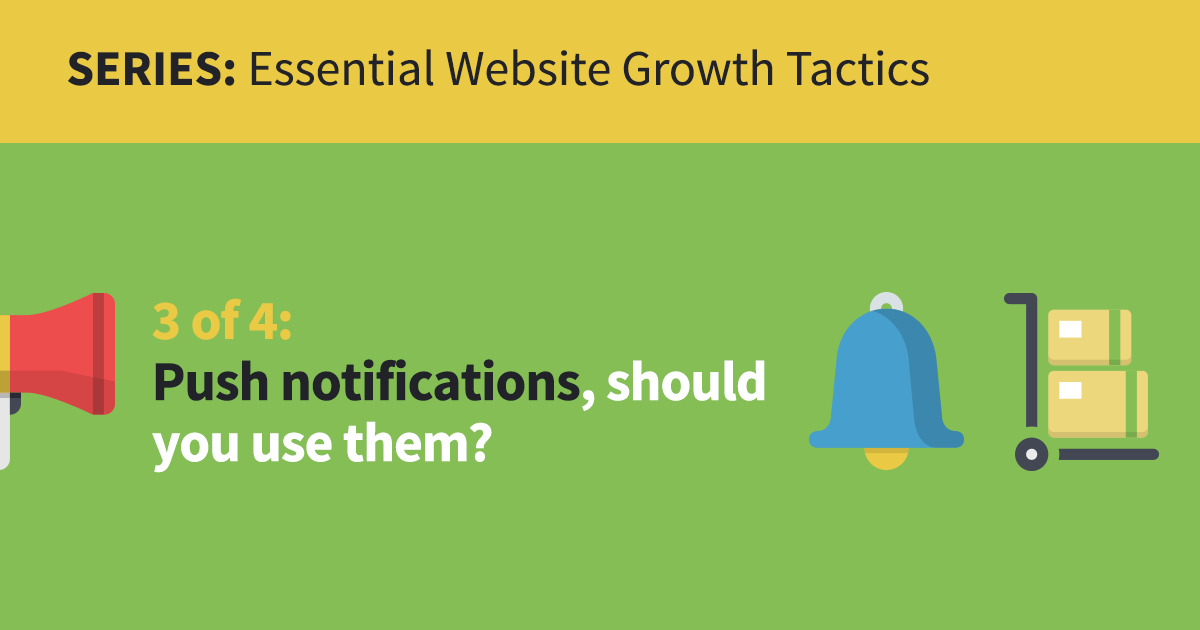

Article 3 of 4. View the full series at bottom of the article.
When it comes to mobile apps, push notifications have been around for some time now. They have been effectively used as a prompt; a reminder that there is something new or updated for you to take notice of and check out. Whether it’s a Skype notification, a new message on Facebook, or something happening in your favourite game, push notifications have provided an instant and timely way to get in touch with users about the latest happenings, events and promotions.
While this has been extremely handy technology for those businesses and platforms with apps, what about those with websites?
Can push notifications be used on your business website and should you implement this technology?
With push notifications set up and enabled on your website, visitors are prompted to opt in to receive notifications from you. When they do, any time there is an update or message you want to send your push notification subscribers, a clickable message will appear in the end user’s browser, very similar to the kind we receive on our mobile phones from apps.
One of the real advantages of web push notifications is that they can be accessed on all devices:
Subscribers have full control over what types of notifications they want to receive and to what devices they wish to receive them.
For those businesses that operate in the eCommerce sector, web push notifications offer a fantastic way to alert subscribers and customers about the latest deals and sales. Now companies don’t need to wait until a subscriber checks their email to discover the latest hot offers. Customers can now be made aware of them virtually in real time.
But push notifications for the web are not reserved for eCommerce sites alone. In fact, any website can make positive use of the latest push notification technology. Even those running a simple blog can use push notifications to alert readers to their latest posts.
Web push notifications are not only a fantastic way to generate traffic, but you can effectively give your site a real traffic boost almost instantaneously.
Many businesses and personal websites take advantage of email marketing and have adopted ways of gaining subscribers to their email lists. Web push notifications is like an extension to this ploy to both retain potential customers as well as giving businesses the ability to communicate with customers any time they desire. Email marketing is great and will always have its place, but it’s not all that effective in getting the message out for time-sensitive offers, whereas push notifications solve this problem.
Push notifications in the mobile app world are reported to have higher response rates than other forms of communicating with customers and subscribers; such as email and social media posting. Technically these kind of alerts are more “in your face” than other forms of contact, but at the same time are not overly intrusive.
Real-time alerts get people to take action more effectively than any other form of communication, and that’s one of the compelling reasons why businesses should seriously consider adding push notifications to their websites.
For starters, push notifications for apps are limited to mobile devices and tablets, whereas web notifications can be sent to mobile devices as well as desktop computers.
Previously, in order to have access to push notification technology, businesses were required to spend money developing a quality app for phones and tablets, usually in both Android and IOS formats. This is often time-consuming and can prove to be expensive. With the web version of push notifications, bypassing developing an app is now possible, as notifications can be sent to tablets and mobile phones via the company’s website instead.
Just like with any other form of communication over the web or through mobile technology, push notifications can be abused. With the fact that these notifications can be delivered in real time, some businesses might be tempted to push the envelope a little and bombard their subscribers with alerts and messages.
Rather than being a positive and productive way to get in touch with customers, spamming them with too many messages in a short space of time will have the complete opposite effect and actually drive customers away.
Like any form of effective communication, use push notifications wisely and never be tempted to overdo it, even out of mere enthusiasm for the technology. Plan your notifications, test and adapt until you discover what works best and how often to use them.
Push notifications have a character limit, so it’s imperative to be succinct when it comes to writing your copy. You need to effectively be able to get your message across, including a possible call to action, in a rather short space. The character limit range various depending on the platform, but it can be anywhere from 40-120 characters.
As web push notifications will not be floating around someone’s email inbox to be opened at will, it’s important to time when your notifications go out. Essentially push notifications, by nature, require an immediate response, so you don’t want to be sending them out at midnight, hoping to get a flood of responses in the morning. Timing shouldn’t be an issue if your business targets a specific area, but if your business is global by nature, then you will need to formulate a strategy to get your message out at opportune moments in various time zones.
You also need to consider defining your subscribers and placing them into various categories if your businesses encompasses a varied range of products or services. For example, if you have an offer that specifically targets pregnant women, you don’t want to be sending that message out to all the single men on your subscriber list.
Push notifications for the web will soon become an essential part of your marketing and promotional mix. They are the perfect solution for being able to communicate with your customers in real time, increase engagement with your website and brand, and grow your customer base and your business’s bottom line.
Now you are able to communicate with subscribers across all platforms without the need to create a mobile app.
© 2025 Itag Media | Legals | Privacy Policy | Site Map
your brand. made better